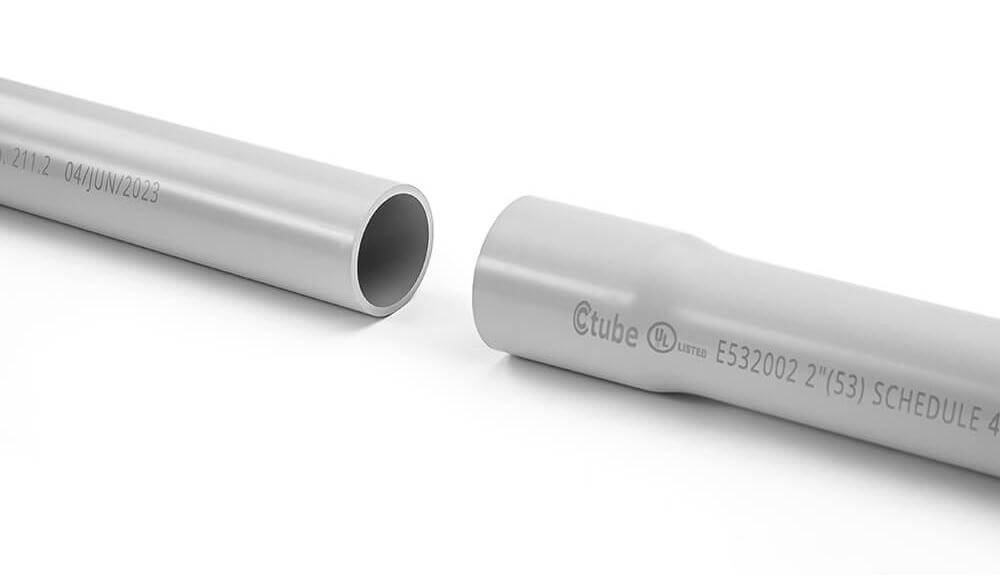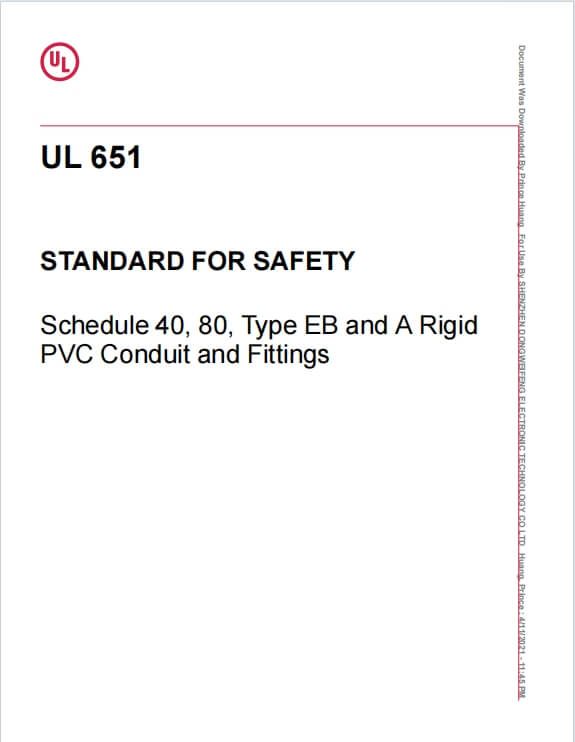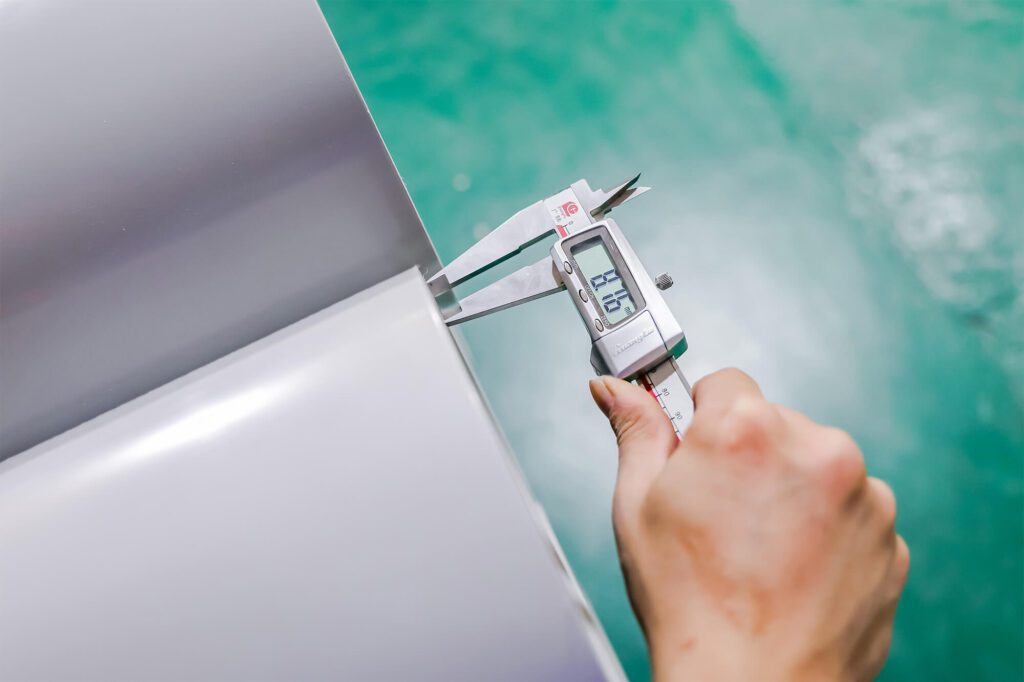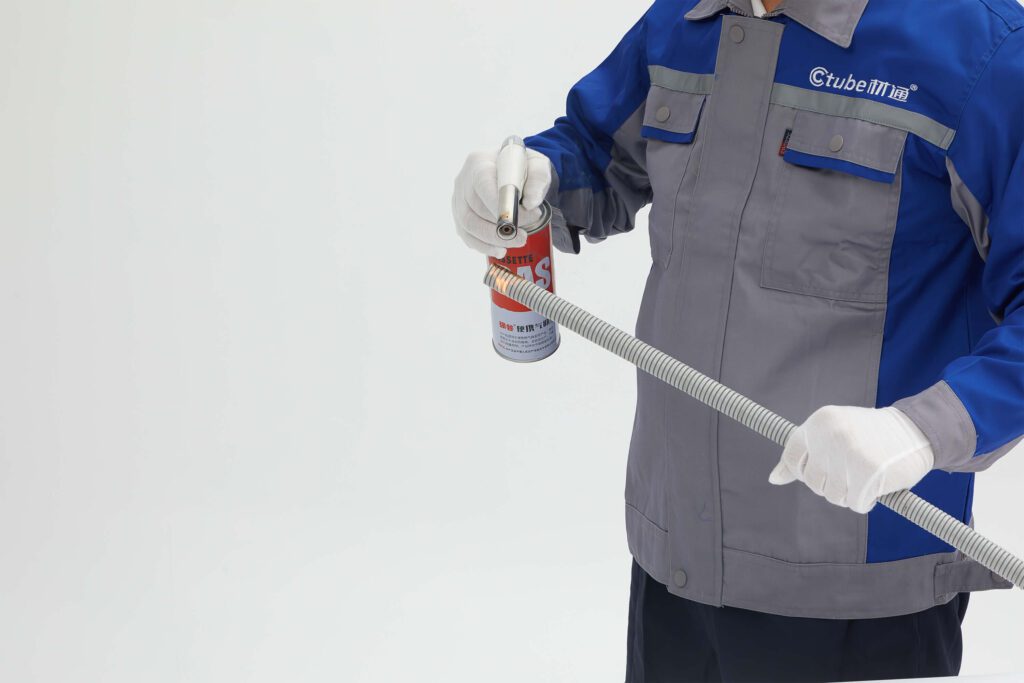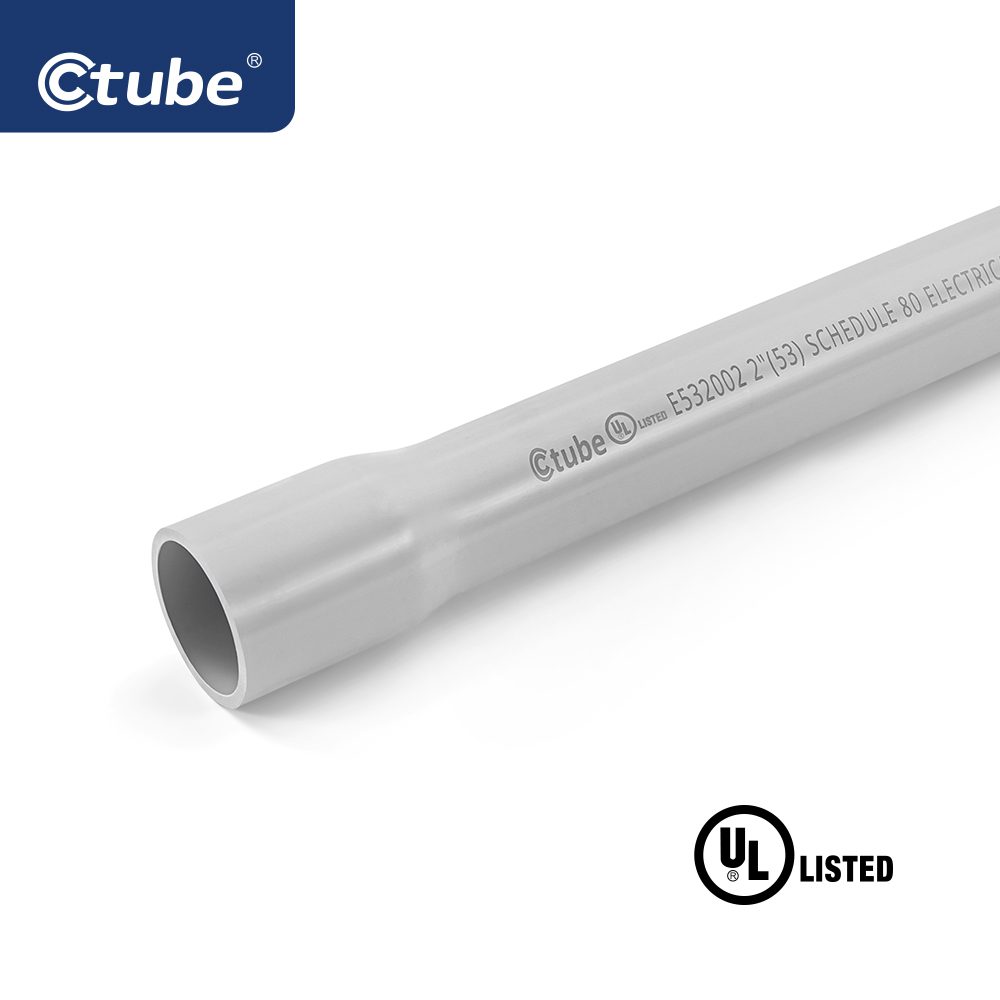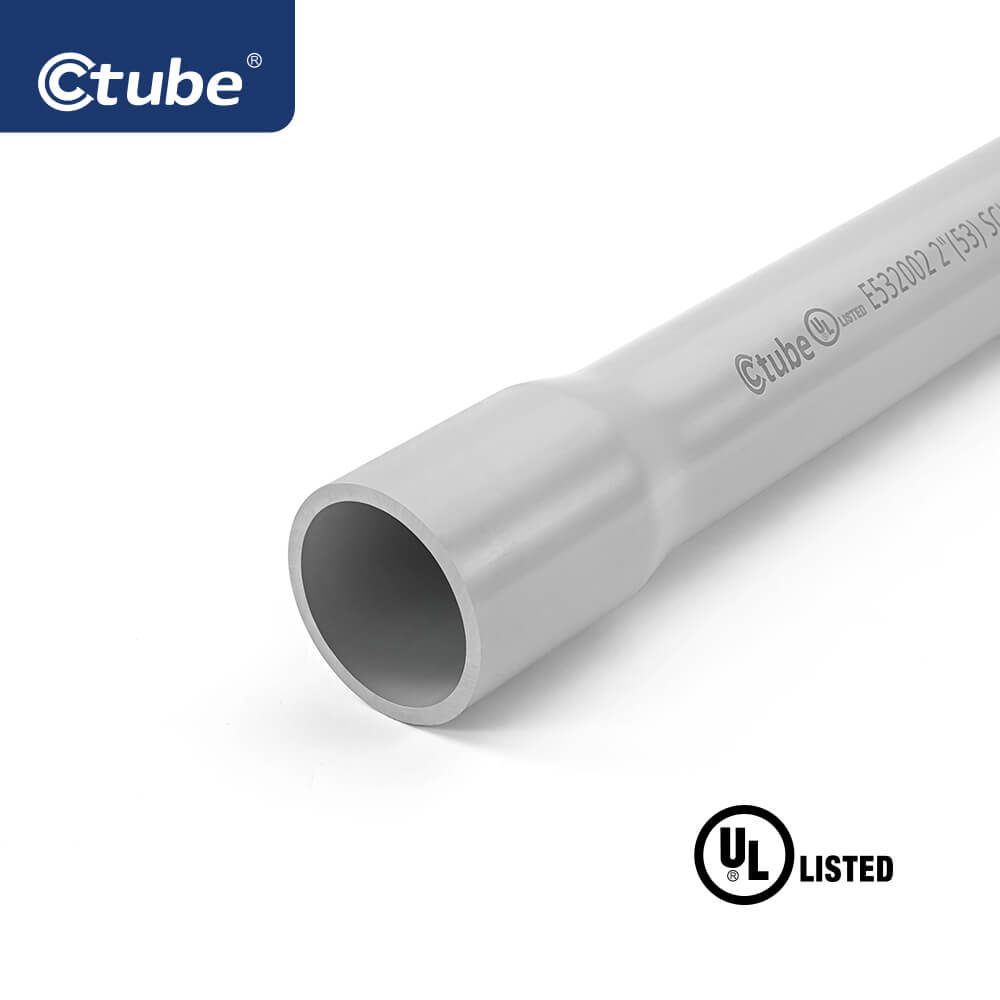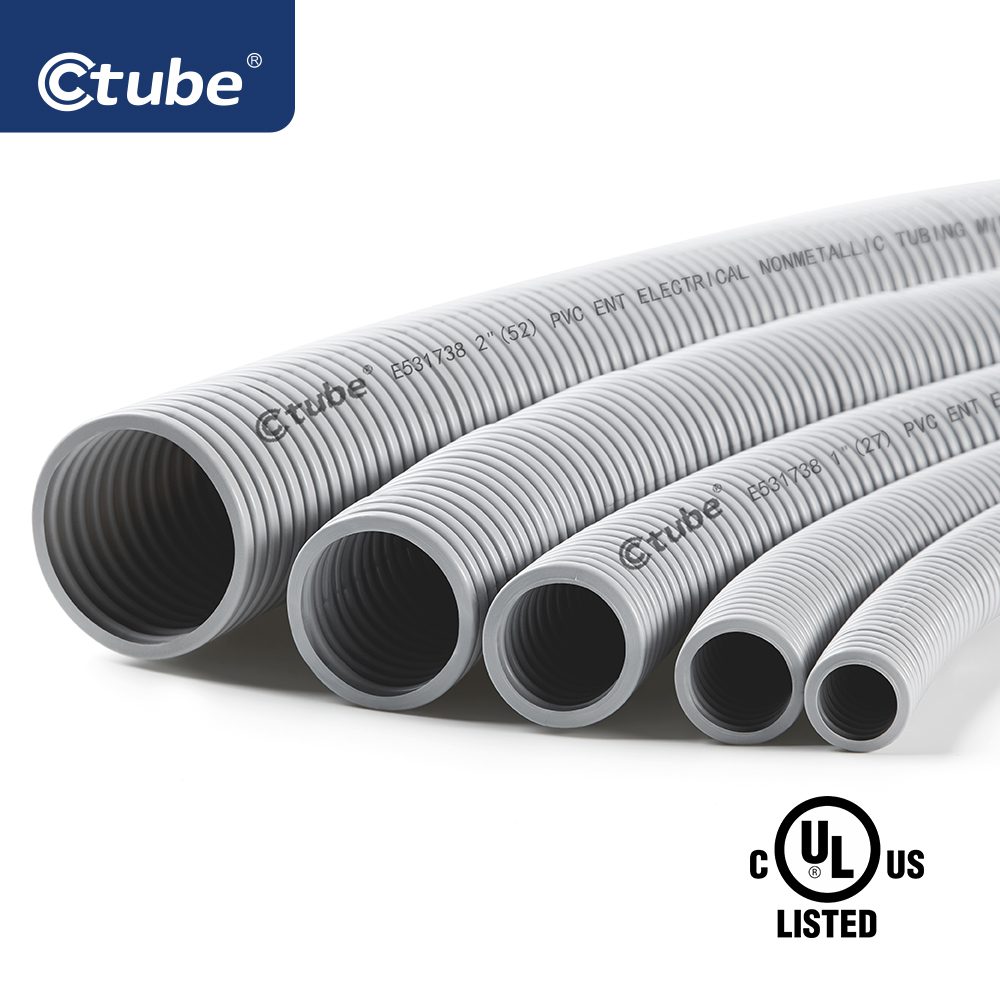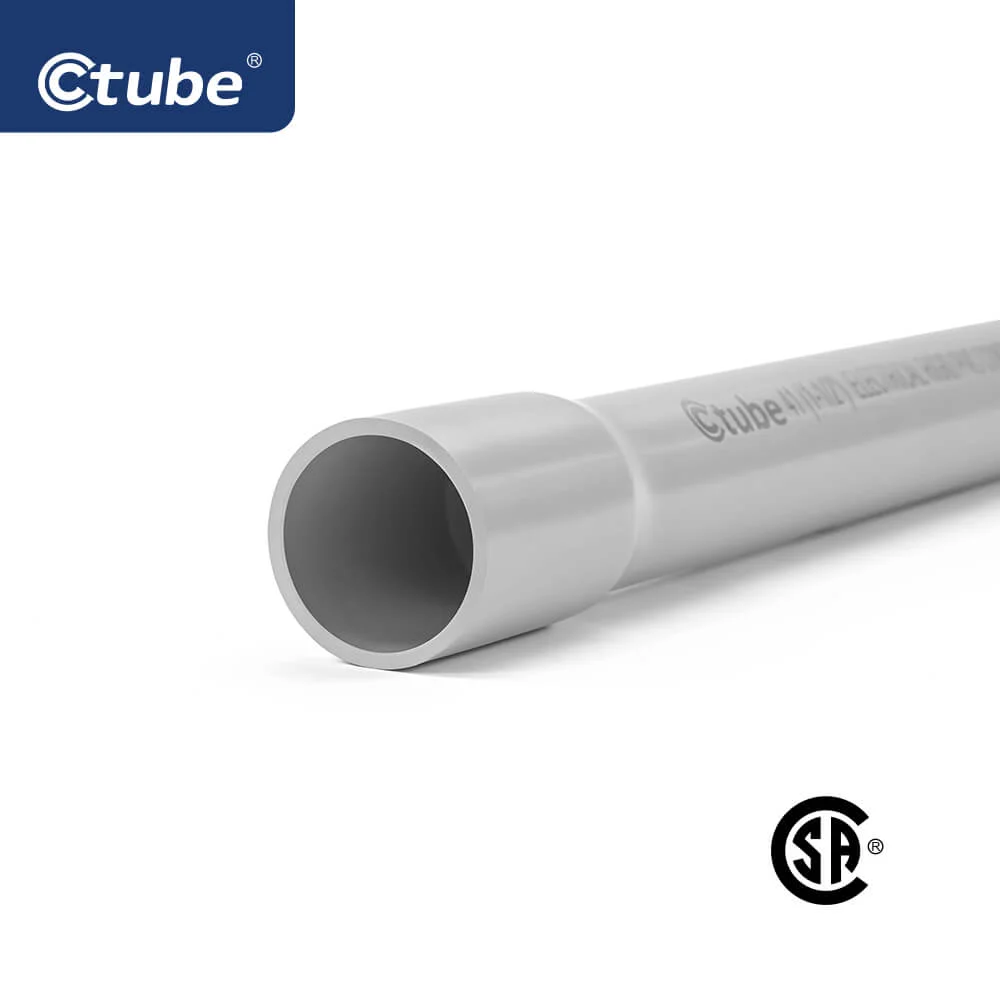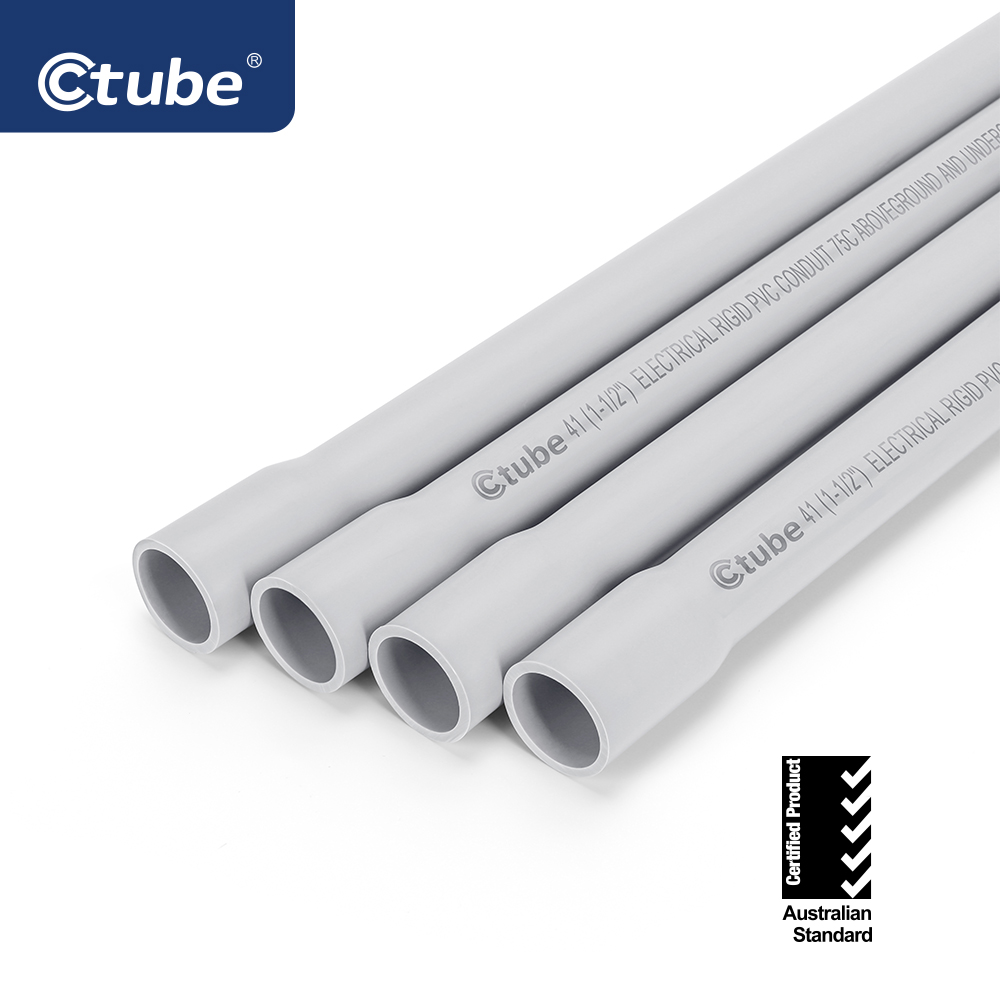Table des matières
Basculer1. Introduction
🔌 Lorsqu'il s'agit de protéger le câblage électrique dans les projets résidentiels, commerciaux ou industriels, le conduit en PVC Schedule 40 est l'une des solutions les plus utilisées et les plus fiables.
Reconnu pour sa durabilité, sa résistance à la corrosion et son rapport coût-efficacité, le conduit Schedule 40 est une option de choix pour les installations aériennes et souterraines.
🚧Mais que signifie exactement “ Schedule 40 ” ? Comment se compare-t-il à d’autres types de conduits, tels que le Schedule 80 ou les conduits métalliques rigides ?
Quelles certifications, comme la certification UL ou la conformité aux normes NEC, devez-vous rechercher ? Et à quelle profondeur doit-il être enterré pour une utilisation sûre et légale ?
💡 Que vous soyez électricien agréé, ingénieur de projet ou responsable des achats, ce guide vous expliquera tout ce que vous devez savoir sur les conduits en PVC Schedule 40.
Des spécifications détaillées et des tests de performance à la profondeur d'installation et à la conformité aux normes, nous vous aiderons à faire des choix éclairés et à garantir la durabilité de votre système électrique.
2. Que signifient “ Schedule ” et “ 40 ” dans le contexte des conduits en PVC Schedule 40 ?
Vous avez probablement déjà vu la mention “ Schedule 40 ” imprimée sur des conduits en PVC. Mais que signifie-t-elle exactement ?
🤔 Est-ce une taille ? Un indice de résistance ? Un code de pression ? Analysons cela ensemble.
🧱 Que signifie “ planning ” ?
Le terme “ Schedule ” désigne un code normalisé utilisé pour définir l'épaisseur de paroi d'un tuyau ou d'une conduite. Il ne mesure pas directement la pression, mais des parois plus épaisses signifient généralement que la conduite peut résister à des chocs ou des contraintes plus importants.
✅ Considérez le “ Schedule ” comme un moyen de classer les tuyaux en fonction de l’épaisseur et de la résistance des parois, et cela dépend de la taille nominale du tuyau (NPS).
📏 Qu'est-ce que la taille nominale d'un tuyau (NPS) ?
NPS signifie Nominal Pipe Size (taille nominale des tuyaux) et est utilisé en Amérique du Nord pour décrire le diamètre extérieur des tuyaux.
Le diamètre extérieur (DE) reste le même pour chaque taille nominale (comme 2″, 3″, 4″).
L'épaisseur de la paroi varie en fonction du programme (par exemple 40 ou 80).
Le conduit Schedule 40 est couramment utilisé dans les maisons résidentielles 🏠, les bâtiments commerciaux 🏢 et les installations souterraines légères 🚧.
C'est un choix polyvalent qui répond aux principales normes de l'industrie, notamment UL 651 pour les conduits électriques et ASTM D1785 pour les tuyaux en plastique résistants à la pression.
Ce qui signifie que… le diamètre intérieur (DI) change également.
🧮 Par exemple :
Un conduit en PVC Schedule 40 de 2 pouces a un diamètre extérieur de 2,375 pouces et une épaisseur de paroi de 0,154 pouce.
Son diamètre intérieur est donc d'environ 2,067 pouces.
Non, un tuyau de 2 pouces n'a pas toujours un trou de 2 pouces à l'intérieur 😄.
🔢 Que vous révèle réellement le “ Schedule 40 ” ?
“ Schedule 40 ” signifie que le conduit a une épaisseur de paroi moyenne — suffisamment épaisse pour la plupart des installations électriques, mais toujours légère et facile à manipuler.
Le conduit Schedule 40 est couramment utilisé dans les maisons résidentielles 🏠, les bâtiments commerciaux 🏢 et les installations souterraines légères 🚧.
C'est un choix polyvalent qui répond aux principales normes de l'industrie, notamment UL 651 pour les conduits électriques et ASTM D1785 pour les tuyaux en plastique résistants à la pression.
3. Quelles sont les principales spécifications des conduits en PVC de type Schedule 40 ?
🧱 Composition du matériau: Les conduits électriques de type Schedule 40 sont fabriqués en polychlorure de vinyle (PVC) rigide, un thermoplastique.
📐 Dimensions standard
| Taille (en pouces) | DO (en pouces) | ID Min Moy (en) | Épaisseur de paroi minimale (en pouces) |
|---|---|---|---|
| 1/2″ | 0.840 | 0.578 | 0.109 |
| 3/4″ | 1.050 | 0.780 | 0.113 |
| 1″ | 1.315 | 1.004 | 0.133 |
| 1-1/4″ | 1.660 | 1.335 | 0.140 |
| 1-1/2″ | 1.900 | 1.564 | 0.145 |
| 2″ | 2.375 | 2.047 | 0.154 |
| 3″ | 3.500 | 3.068 | 0.216 |
| 4″ | 4.500 | 3.826 | 0.237 |
| 6″ | 6.625 | 5.958 | 0.280 |
| 8″ | 8.625 | 7.853 | 0.322 |
📌 NoteCe tableau est fourni à titre indicatif uniquement. Les dimensions réelles peuvent légèrement varier d'un fabricant à l'autre, ce qui est tout à fait normal tant qu'elles respectent les tolérances définies par les normes UL et NEMA.
📏 Longueur et assemblageCes conduits sont disponibles en longueurs droites de 3,05 mètres (10 pieds), avec une extrémité évasée pour faciliter l'assemblage par collage. Certaines versions sont également dotées de raccords intégrés, ce qui simplifie encore davantage l'installation.
4. Quelles sont les exigences détaillées en matière de tests pour les conduits en PVC de type Schedule 40 ?
Lorsque vous choisissez un conduit en PVC Schedule 40 pour des travaux électriques, il ne s'agit pas seulement de la taille ou de l'épaisseur de la paroi ; la sécurité et la qualité sont tout aussi importantes.
Comment savoir si un conduit est sûr à utiliser ? C’est là qu’interviennent des certifications comme la norme UL 651.
Examinons ensemble ce que signifient ces normes — et pourquoi vous devriez vous en soucier.
🔎 Qu'est-ce que la norme UL 651 ?
UL signifie Underwriters Laboratories, une organisation de confiance qui teste les produits pour en vérifier la sécurité et la performance.
💡 Considérez la norme UL 651 comme un label d'approbation : elle montre que le conduit est testé, fiable et prêt à être utilisé dans des systèmes électriques réels.
Pour garantir la sécurité et la performance, les conduits en PVC Schedule 40 doivent satisfaire à des exigences de test strictes avant de pouvoir porter le label de certification UL 651.
🧱 Matériaux et fabrication
Avant toute chose, parlons de la composition réelle des conduits en PVC de type Schedule 40.
Pour être homologué UL, le matériau doit répondre à une norme élevée connue sous le nom d'ASTM D1784, qui définit les règles relatives au type de composé PVC autorisé.
Plus précisément, les conduits rigides en PVC de la série 40 doivent respecter ou dépasser une classification cellulaire de 12123, un code qui définit la résistance, la flexibilité et la résistance du matériau à la chaleur et aux chocs.
✅ Exigences de la norme ASTM D1784-20 relatives aux composés de PVC
Selon ASTM D1784-20, Le composé PVC utilisé pour les conduits Schedule 40 doit répondre à des critères de performance stricts dans les domaines suivants :
- Résistance à la traction – la limite d'étirement du matériau avant rupture
- Résistance aux chocs – sa capacité à résister aux chutes et aux chocs
- Module d'élasticité – la rigidité ou la flexibilité du matériau
- Température de déflexion – comment le matériau se comporte lorsqu'il est exposé à la chaleur
- Inflammabilité – la façon dont le matériau réagit au feu ou aux sources d’inflammation
La matière première PVC est généralement fournie sous forme de cubes, granules ou poudre. Il doit s'agir de :
- Apparence propre et uniforme
- Exempt de toute contamination ou substance étrangère
Lors de la fabrication, des additifs sûrs peuvent être incorporés au composé pour améliorer le procédé et les performances. Parmi les additifs courants, on trouve :
- Lubrifiants
- Stabilisateurs
- pigments de couleur
- produits de comblement – améliorer les caractéristiques de structure ou de traitement
Pourvu que le composé final de PVC contienne au moins 80% chlorure de vinyle et réussit tous les tests requis, il est approuvé pour une utilisation dans la production de conduits électriques de type Schedule 40.
👉 En bref, cela signifie que chaque conduit est fabriqué à partir de matériaux de haute qualité, soigneusement testés, ce qui vous garantit des performances durables et fiables.
📏 Dimensions
En matière de conduits, les dimensions sont essentielles, et pas seulement pour le passage des câbles. Conformément aux normes UL 651 et ASTM, les conduits en PVC Schedule 40 doivent respecter des règles strictes concernant leur diamètre extérieur, leur épaisseur et leurs tolérances de longueur. Ceci garantit la cohérence, la sécurité et la compatibilité avec les raccords et autres systèmes de conduits.
📌 NoteComme indiqué précédemment, les dimensions exactes (diamètre extérieur, épaisseur de paroi et tolérance de longueur, par exemple) peuvent légèrement varier d'un fabricant à l'autre. Cela n'est pas problématique, tant que le produit respecte les tolérances admissibles définies par les normes UL 651 ou ASTM.
🔬 Conditions de test
Avant tout essai de performance, les échantillons de conduits en PVC Schedule 40 doivent subir un préconditionnement. Cette étape garantit des résultats justes, précis et cohérents, quel que soit le fabricant ou le laboratoire effectuant les tests.
🕒 Que signifie le préconditionnement ?
Cela signifie simplement placer les échantillons à tester dans un environnement stable pendant une certaine période avant de procéder aux essais. Voici les exigences pour les conduits en PVC de type Schedule 40 :
Tous les échantillons doivent être conservés pendant au moins 24 heures à l'air calme, à une température de
23,0 ±2,0°C (73,4 ±3,6°F) avant tout test de performance.
Cette condition standard permet d'éliminer l'influence des opérations de fabrication, de transport ou d'exposition environnementale récentes. Elle permet au matériau de se stabiliser dans un état normal, de sorte que les tests reflètent le comportement du produit en conditions réelles d'installation.
🌡️ Pourquoi cette température ?
La température de 23 °C (ou 73,4 °F) est considérée comme la température ambiante dans les normes d'essai. Il s'agit d'une référence internationale utilisée pour de nombreuses évaluations de matériaux et de produits afin d'assurer la cohérence des résultats.
✅ Quels types de tests utilisent cette condition ?
Presque tous les essais de performance — résistance aux chocs, résistance à l'écrasement, résistance à la traction et inflammabilité — exigent un préconditionnement des échantillons. Cette étape fait partie des protocoles d'essai UL 651 et ASTM afin de garantir des résultats fiables.
🔬 Comment teste-t-on les conduits de type Schedule 40 ?
| Test | Exigence |
|---|---|
| Résistance à la traction | 5 000 psi (34,5 MN/m²) (3,45 kN/cm²) (3 515 gf/mm²) pour le Schedule 40 |
| Absorption d'eau | Le produit fini de la série 40 ne doit pas absorber plus de 0,501 TP3T de son propre poids après 24 heures dans de l'eau distillée. |
| Résistance aux impacts | Ne doit pas se fissurer ou se déchirer sur une longueur supérieure à 0,8 mm (1/32 pouce) le long de la surface extérieure. |
| résistance à la flamme | Les échantillons verticaux ne doivent pas être exposés à la flamme pendant plus de 5 secondes après chacune des trois applications de flamme de 60 secondes (avec des intervalles de 30 secondes). |
| Résistance à la lumière solaire | Après 720, 1080 ou 1440 heures de conditionnement, doivent conserver une résistance moyenne aux chocs Izod*. |
Seule une partie du contenu est mentionnée à titre indicatif. Veuillez consulter la norme UL 651 pour obtenir tous les détails.
* Le test de résistance aux chocs Izod est une méthode normalisée ASTM permettant de déterminer la résistance aux chocs.
Test d'inflammabilité
La norme UL 94 teste la réaction du matériau à la flamme et le classe en fonction de la rapidité avec laquelle il s'éteint.
| Classe | Orientation de l'échantillon d'essai | Définition | Durée de combustion autorisée | Drop d'entraînement autorisé | Trous de plaque |
|---|---|---|---|---|---|
| Norme UL 94 HB | Horizontal | Combustion lente | Vitesse de combustion inférieure à 76 mm/min pour un échantillon de moins de 3 mm d'épaisseur et arrêt de la combustion avant 100 mm. | / | / |
| UL 94 V-2 | Verticale | La combustion s'arrête | Années 30 | Flamboyant : Oui Non inflammable : Oui |
/ |
| UL 94 V-1 | Verticale | La combustion s'arrête | Années 30 | Flamboyant : Non Non inflammable : Oui |
/ |
| UL 94 V-0 | Verticale | La combustion s'arrête | 10s | Flamboyant : Non Non inflammable : Oui |
/ |
| UL 94 5VB | Verticale | La combustion s'arrête | Années 60 | Flamboyant : Non Non inflammable : Non |
Oui |
| UL 94 5VA | Verticale | La combustion s'arrête | Années 60 | Flamboyant : Non Non inflammable : Non |
Non |
Les notes sont les suivantes :
Le Code canadien de l'électricité (CCE), publié par l'Association canadienne de normalisation, est le code de sécurité canadien pour les installations électriques qui est adopté en loi par chaque province et territoire, avec des modifications ou des règles locales.
Le code fait référence à une série rigoureuse d'essais mis au point pour tester la résistance à la flamme des fils et câbles. Les câbles sont marqués de FT1 à FT6, selon les exigences d'essai à la flamme spécifiées auxquelles ils satisfont.
Voici les détails des méthodes de test et des critères d’évaluation :
| Test | Installation | Débit de flamme | Durée | Critères de réussite/échec |
|---|---|---|---|---|
| FT1 | Verticale | 3 000 BTU/heure | 5×15s | Un conducteur fini ne doit pas transmettre de flamme ni continuer à brûler pendant plus de 60 secondes après cinq applications de 15 secondes de la flamme d'essai. Si plus de 25% de la partie étendue de l'indicateur est brûlée, le conducteur est considéré comme ayant transmis une flamme. |
| FT2 | Horizontal | 1 700 BTU/heure | Années 30 | La longueur de la partie carbonisée de l'échantillon de corde ne doit pas dépasser 100 mm et elle ne doit pas laisser tomber de particules enflammées. |
| FT4 | Verticale | 70 000 BTU/heure | 20 min | Les fils ou câbles finis ne doivent pas présenter de matière carbonisée au-delà d'une longueur supérieure à 1,5 m (5 pi) du bord inférieur de la face du brûleur lorsqu'ils sont soumis au test. |
| FT5 | Horizontal | 1 700 BTU/heure | Années 60 | La longueur de la zone brûlée du câble ne doit pas dépasser 150 mm et il ne doit pas continuer à brûler pendant plus de quatre minutes lors de l'essai à la flamme. |
| FT6 | Horizontal | 300 000 BTU/heure | 20 min | A flame travel distance not exceeding 1.52 m (5 ft), a peak optical density of smoke not exceeding 0.5, and an average optical density not exceeding 0.15 are described as having adequate fire-resistant and low smoke-producing characteristics. |
Résistance aux UV
When plastic materials are exposed to sunlight for long periods, the UV (ultraviolet) rays can break down their molecular structure.
🌞 This process is called photodegradation, and it’s a big problem for outdoor plastics like electrical conduits.
Here’s what happens:
UV rays damage the chemical bonds in the plastic.
This creates free radicals—tiny, unstable atoms that attack nearby molecules.
⚠️As the damage spreads, the plastic starts to crack, discolor, and lose strength and flexibility.
And when that happens? It puts your electrical cables at serious risk, especially in outdoor or exposed installations.
To make sure plastic conduits can survive years of sun exposure without failing, manufacturers do special UV testing.
🌤️ This test simulates long-term sunlight exposure (like 8 years!) in a short amount of time—about 480 hours in a lab.
The test checks for things like:
🔹 Color fading
🔹 Loss of impact strength
🔹 Reduced flexibility or brittleness
🌎✅ What’s tested can vary depending on the application, but the goal is always the same: to make sure the material can hold up under sunlight, just like it would in real life.
Marking
🛠️✅Every piece of Schedule 40 PVC conduit must have clear and permanent markings on it. These markings aren’t just for show — they tell you important information and help make sure everything is up to code.
Here’s what the marking includes:
✅ The UL symbol – this means the conduit has been tested and approved under UL 651, a trusted safety standard.
🔤 The type of conduit (e.g., “Schedule 40 PVC”).
📘 The UL standard number.
🏭 The manufacturer’s name.
📏 The conduit size (like 1/2″, 1″, etc.).
These markings help installers and inspectors quickly verify that the conduit is certified and suitable for the job. No guesswork needed!
5. Quelles sont les applications courantes des conduits en PVC de type Schedule 40 ?
Schedule 40 PVC conduit is a versatile and durable choice for running electrical wiring. Thanks to its moisture resistance and toughness, it can be installed above ground or underground, and works well in a variety of environments.
🏡In Residential Homes
Schedule 40 PVC is commonly used to run electrical wires through homes—inside walls, basements, attics, and garages. It’s also great for outdoor applications like garden lighting, landscape power lines, and pool wiring, where the conduit needs to resist moisture and weather. Homeowners love it because it’s lightweight, easy to cut, and long-lasting.
🏬In Commercial Buildings
In places like offices, shops, and public buildings, this conduit helps route both power and communication cables. You’ll find it hidden behind walls, ceilings, and under floors. It’s a cost-effective and easy-to-install option, making it perfect for both new buildings and remodel projects.
🏗️In Industrial Facilities
Factories and warehouses also rely on Schedule 40 PVC conduit. It helps protect wires from chemicals, moisture, and physical impacts—all of which are common in industrial environments. Whether it’s heavy-duty equipment or automated systems, this conduit keeps cables safe and running smoothly.
6. À quelle profondeur un conduit en PVC de type Schedule 40 doit-il être enterré ?
🌱🛠️If you’re planning to run Schedule 40 PVC conduit underground, you’ll need to follow burial depth guidelines to keep your installation safe and up to code. These depths are based on recommendations from the National Electrical Code (NEC) and help prevent accidental damage from digging or heavy loads.
| Type d'installation | Minimum Burial Depth | Explanation |
|---|---|---|
| Enterrement direct | 18 inches (45 cm) | Conduit placed directly in soil must be at least 18″ deep to protect against tools, digging, and surface loads. |
| Concrete Encasement | 6 inches (15 cm) | When conduit is encased in concrete, the required depth is reduced due to added protection. |
| Under a 2-inch Concrete Slab | 12 inches (30 cm) | If installed under a concrete slab at least 2″ thick, 12″ depth is acceptable because the slab offers moderate shielding. |
| 💡 Pro Tip: Always check local codes or utility regulations—some areas may have stricter rules than the NEC! | ||
What Affects How Deep Should Bury Conduit?
🌍🚧 While the NEC provides general rules for how deep to bury Schedule 40 PVC conduit, the actual depth may need to be adjusted depending on site-specific conditions. Here are some key factors to consider before you start digging:
| Facteur | Explanation |
|---|---|
| Soil Type | – Loose or sandy soil may shift, so deeper burial helps maintain stability. – Dense or compacted soil offers better natural support, requiring less depth. |
| Freezing Temperatures (Frost Line) | – In cold regions, conduit must be buried below the frost line. – Freeze-thaw cycles can move soil, risking conduit damage. – Check local building codes or regional frost data. |
| Traffic Loads | – If installed under driveways, roads, or parking lots, conduit may need deeper burial or concrete encasement. – This prevents damage from pressure and vibration. |
| Installation Method | – Direct burial needs more depth due to exposure to the elements. – Concrete encasement allows shallower burial by adding protection. |
✅ Tip: Always consult your local electrical code or a licensed electrician to confirm the exact requirements for your area. They may differ from the NEC based on regional conditions.
| ARTICLE 300 — GENERAL REQUIREMENTS FOR WIRING METHODS AND MATERIALS | |||||
|---|---|---|---|---|---|
| Table 300.5 Minimum Cover Requirements, 0 to 1000 Volts, Nominal, Burial in Millimeters (Inches) (Type of Wiring Method or Circuit) |
|||||
| Location of Wiring Method or Circuit | Column 1 Direct Burial Cables or Conductors |
Column 2 Rigid Metal Conduit or Intermediate Metal Conduit |
Column 3 Nonmetallic Raceways Listed for Direct Burial |
Column 4 Residential Branch Circuits Rated 120V or Less with GFCI |
Column 5 Circuits for Control of Irrigation and Landscape Lighting |
| mm / in. | mm / in. | mm / in. | mm / in. | mm / in. | |
| All locations not specified below | 600 / 24 | 150 / 6 | 450 / 18 | 300 / 12 | 150a,b / 6a,b |
| In trench below 50 mm (2 in.) thick concrete or equivalent | 450 / 18 | 150 / 6 | 300 / 12 | 150 / 6 | 150 / 6 |
| Under a building | 0 | 0 | 0 | 0 (in raceway or Type MC or MI) | 0 (in raceway or Type MC or MI) |
| Under min. 102 mm (4 in.) thick concrete slab with no traffic & 152 mm (6 in.) beyond installation | 450 / 18 | 100 / 4 | 100 / 4 | 150 / 6 (direct burial) 100 / 4 (in raceway) |
150 / 6 (direct burial) 100 / 4 (in raceway) |
| Under streets, highways, roads, alleys, driveways, and parking lots | 600 / 24 | 600 / 24 | 600 / 24 | 600 / 24 | 600 / 24 |
| One- and two-family dwelling driveways and outdoor parking (dwelling only) | 450 / 18 | 450 / 18 | 450 / 18 | 300 / 12 | 450 / 18 |
| In or under airport runways, including adjacent no-trespassing areas | 450 / 18 | 450 / 18 | 450 / 18 | 450 / 18 | 450 / 18 |
7. Quelle est la différence entre les conduits en PVC de type Schedule 40 et Schedule 80 ?
🔍Both Schedule 40 and Schedule 80 PVC conduits are used to protect electrical wiring—but they’re built a bit differently, and each one is better suited for certain types of jobs.
Let’s take a closer look at how they compare:
| Catégorie | Annexe 40 | Annexe 80 |
|---|---|---|
| Épaisseur de la paroi | Has a thinner wall, which makes it lighter and easier to handle. It’s ideal for most residential and light commercial uses where extreme durability isn’t required. | Features a thicker wall, giving it more strength and impact resistance. This extra durability helps protect wires in rougher environments. |
| Pressure and Impact Resistance | Works well in areas where the conduit won’t be exposed to heavy pressure or physical damage. Great for general use in homes and buildings. | Has a higher pressure rating and is built to withstand harsher conditions, such as in industrial sites or areas with a risk of impact. |
| Coût | More budget-friendly because it uses less material. It’s a smart choice for most standard jobs where extreme strength isn’t needed. | Typically more expensive due to its thicker construction and improved durability. |
| Installation Difficulty | Easier and faster to install thanks to its light weight and flexibility. It’s easier to cut and bend too. | Tougher to work with because of the thicker wall. It may require more effort and tools during installation. |
8. Conclusion
Conduit en PVC de catégorie 40 remains a trusted choice in residential, commercial, and even some light industrial electrical installations. Its balance of durability, ease of use, and cost-effectiveness makes it a go-to solution for protecting electrical wiring above ground, underground, or embedded in concrete.
By understanding the relevant standards, installation requirements, and the differences between Schedule 40 and other conduit types like Schedule 80 or RMC, electricians and contractors can ensure safe, compliant, and long-lasting electrical systems.
Whether you’re planning a small project or managing a large infrastructure job, choosing high-quality, certified products—like those offered by Ctube—can make all the difference in performance and safety.
Ctube’s Schedule 40 and Schedule 80 rigid PVC conduits are UL and CSA certified, offering dependable performance across residential, commercial, and industrial applications.
With additional global certifications such as SGS, RoHS, CE, and IEC, Ctube products meet international standards and are trusted for their durability, safety, and long-lasting quality.
Thank you for reading. We hope this guide has been helpful and wish you success with your project.
For any project inquiries or further assistance, contact us.
FAQ
Q1: What’s the difference between Schedule 40 electrical conduit and Schedule 40 plumbing pipe?
40 electrical conduit is made to protect wires. It’s UV-resistant, flame-retardant, and has a smooth interior to help with wire pulling. It follows electrical safety standards.
Schedule 40 plumbing pipe is used for water or fluid transport. It focuses on pressure resistance and meets plumbing codes.
Even if they look similar, they are made for different purposes and should not be used interchangeably.
Q2: What tools do I need to cut and install Schedule 40 electrical conduit?
Tape measure – for accurate length.
PVC cutter or hacksaw – to cut the conduit.
Deburring tool or utility knife – to smooth edges after cutting.
Conduit bender – if bends are needed.
Fittings – like elbows, couplings, or adapters.
PVC solvent cement – to join conduit and fittings.
Marker – to mark where to cut or align parts.
Q3: How is Schedule 40 PVC conduit different from rigid metal conduit (RMC)?
Schedule 40 PVC is plastic, lightweight, corrosion-resistant, and affordable. It’s easier to work with but offers less physical protection.
Rigid metal conduit is made of steel or aluminum. It’s heavy, more durable, and offers better protection, but it’s harder to install and costs more.
Choose PVC for lighter-duty or outdoor work, and RMC for high-impact or industrial areas.

